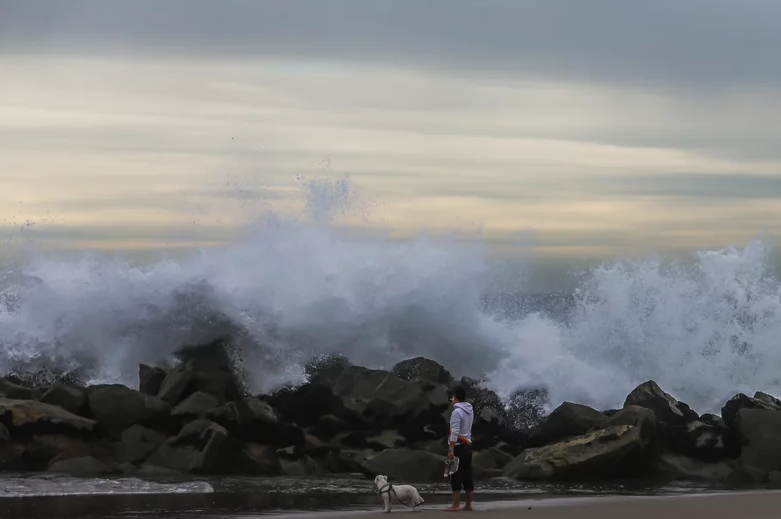A massive underwater volcano that erupted just before sundown Friday sent waves several feet high smashing into the shores of the island nation of Tonga and thousands of miles across the Pacific Ocean from Australia to Canada, including the U.S. West Coast.
Plumes from the explosion reached more than 12 miles above sea level, according to the Tonga Geological Services. At its widest, the cloud caused by the ash and steam reached about 150 miles across, making it easily seen from satellites. The eruption was so massive that its shockwaves were felt as far away as Mount Hood in Oregon.
1.14.2022: (correction on date) Large volcanic eruption near Tonga (Hunga Tonga-Hunga Ha’apai volcano) today as seen from outer space. Shown on visible imagery using the Himawari satellite. #hiwx #tsunami #earthquake pic.twitter.com/Y18W7wvXl9
— NWSHonolulu (@NWSHonolulu) January 15, 2022
In Tonga, home to 105,000 people, the extent of the injuries and damage caused were still largely unknown. The eruption, which filled the sky with so much ash that darkness seemed to fall on Tonga two hours before sunset, has knocked out communications, according to The Associated Press.
Waves flooded parts of the capital Nuku’alofa — just 40 miles from the site of the eruption — including parts of the grounds at the Royal Palace, according to Radio New Zealand.
On Twitter, a Tonga resident named Faka’iloatonga Taumoefolau posted a video on Saturday showing feet-high waves washing across a road into homes.
The activity from the Hunga Tonga-Hunga Ha’apai volcano continued into Saturday morning with another, less powerful 10- to 15-minute-long eruption, according to the Tonga Geological Service.
Geologists saw massive explosions and lightning during the eruption
Taaniela Kula, an official in the country’s Ministry of Lands and Natural Resources, told the news website Matangi Tonga that geologists had observed massive explosions and lightning during the eruption.
“Big day yesterday indeed! It was great getting out there during the volcano’s peak hours. It’s a geologist’s dream to see actual geological events in process,” he said.
Ash from the eruption could contaminate drinking water, the Tonga government warned. Residents were advised to cover water reservoirs and to check their gutter covers and roofs for ash before reconnecting rainwater systems.
After the eruption late Friday, authorities from nations across the Pacific issued tsunami warnings and advisories, from Fiji and Samoa to as far away as Australia and Canada’s British Columbia.
New Zealand officials warned of “unpredictable surges” on the north and east coasts of the country’s North Island. A 6-foot surge in Tutukaka, a town some 85 miles north of Auckland, damaged a harbor and about 30 boats docked there, according to the New Zealand Herald.
In Australia, a marine threat advisory warned that “dangerous rips, waves and strong ocean currents” were possible.
Both New Zealand and Australia renewed their tsunami advisories early Sunday. “Strong currents and surges can injure and drown people. There is a danger to swimmers, surfers, people fishing, small boats and anyone in or near the water close to shore,” wrote New Zealand’s National Emergency Management Agency.
The Japan Meteorological Agency warned of a tsunami surge across the country’s eastern and southern coasts, with the highest surges expected in the Amami and Tokara Islands, two archipelagos to the south of the country’s largest islands. Rises of nearly four feet were recorded in Amami and near Kuji, a city on the northeastern coast of Honshu.

Tsunami surges felt from Hawaii to the U.S. West Coast
The first U.S. state to feel the effects of the eruption was Hawaii, where waves over a foot were reported in Kauai and nearly three feet tall in Hanalei. “We are relieved that there is no reported damage and only minor flooding through-out the islands,” the Pacific Tsunami Warning Center said.
The waves reached the western shore of the continental U.S. on Saturday morning. The National Weather Service issued a tsunami advisory for the entire West Coast and all of Alaska’s southern coast, warning that strong currents and waves were expected — but not the “significant inundation” of a full-fledged tsunami warning.
According to an NWS update as of 3:15 p.m. ET, the highest surge was recorded in Port San Luis, Calif., where the water reached more than 4 feet over normal levels. The waves topped 3 feet in King Cove in Alaska’s Aleutian islands and Point Arena and Crescent City, Calif., two towns along the Northern California coast.
Authorities had prepared early Saturday for the possibility of a small yet potentially disruptive surge. Beaches were cleared from San Diego to San Francisco. More than 100 people were evacuated from the boats, docks and shoreline of the Berkeley Marina, according to news site Berkleyside.
Stay on higher ground. This is a current look at Miramar Beach in Half Moon Bay. @SMHarbor #CaWx #California @sanmateoco @sccounty pic.twitter.com/irnxkofMGi
— CAL FIRE CZU (@CALFIRECZU) January 15, 2022
Damage appeared to be relatively minor across the West Coast. In Santa Cruz, Calif., a tidal surge flooded the city’s beaches and harbor, causing minor damage, Elizabeth Smith, the city’s communications manager, told CNN.
If unsure about how to handle water damage, seek the help of a dependable water damage company. Ignoring the problem will only make it worse and lead to costly repairs. Water damage can cause structural problems, mould growth, and health issues. Don’t take chances with your safety, seek professional help.







